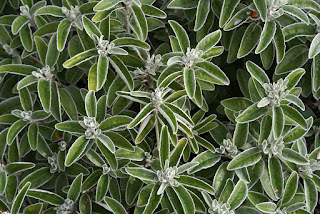Brachyglottis compacta
This week the spotlight has (literally) been on Castlepoint
as the beachside community, and its many friends, has celebrated the centenary
of the switching on of the iconic lighthouse that graces its reef. The lighthouse was showing its true colours
at times over the weekend, but at other times was lit with a variety of bright
lights, surely making it a shipping hazard, as sailors, drawn by the
display, could have been lured siren-like
onto the rocks.
Castlepoint is a wonderful place for a variety of social reasons,
but for gardeners and lovers of native plants and wildlife, there are others
reasons to venture out eastwards, as the reef and the remarkable castellated hill
that Captain Cook called Castle Rock are home to some interesting and
garden-worthy plants.
Prime among these is the Castlepoint groundsel, Brachyglottis compacta. There are many species of Brachyglottis in New Zealand, among them
a cluster of yellow flowering evergreen shrubs of coastal habits, but there are
also inland, and even mountain species, the best known of which is the rangiora, B. repanda.
Castlepoint’s daisy is a bushy, evergreen flowering shrub of low
growing habits – about a metre or so –
and the only place it is found in the world is on the limestone cliffs at the
beach. It has oval shaped leaves about
2–4 cm long which are green above and white below, with slightly toothed edges.
The flowers are yellow and appear in summer.
As you would expect this is a brilliant plant for dry
places, and will flourish through the worst Wairarapa droughts in hot sunny
places, its golden flowers following by wispy white seedheads.
Wairarapa is also home to the similar, but subtly different, B.
greyii, which is found in coastal areas to the south, from about Flat Point
around to the mouth of the Orongorongo river.
It has slightly greyer leaves, but retains the silvery down on the
underside, and gives a greyer appearance that the Castlepoint species. It has an even better display of golden
flowers making this particular species popular overseas. This is another great shrub that does very
well in hot sun, coping well with poor soils.
We have struggled a bit this with plant as it is planted in rubbish
soil, a piece of land previous owners filled with road scrapings. The soil is very heavy and wet in winter, and
these plants are not keen on those conditions.
As you might expect, these species have been crossed, and they are the parents of a number of interesting hybrids including the very popular Brachyglottis ‘Sunshine’, which is another very hardy form with grey leaves and a super abundance of yellow flowers. Overseas there is a variegated form of this plant but it is hard to see how it could be an improvement. ‘Otari Cloud’ is a similar hybrid, and has heaps of bright golden flowers over grey foliage.
As you might expect, these species have been crossed, and they are the parents of a number of interesting hybrids including the very popular Brachyglottis ‘Sunshine’, which is another very hardy form with grey leaves and a super abundance of yellow flowers. Overseas there is a variegated form of this plant but it is hard to see how it could be an improvement. ‘Otari Cloud’ is a similar hybrid, and has heaps of bright golden flowers over grey foliage.
I suspect these plants have become very muddled in the
horticulture trade and buying any one of them might mean you end up with one of
the others!
There is one form that is quite different – Brachyglottis ‘Leith Gold’ is a
Dunedin-raised form with a mix of the attributes of its parents, having large leaves that are similar in size to
rangiora but having the colour and
texture of B.greyii. This interesting
plant has a fairly open habit, again halfway between its parents, and it
carries panicles of small yellow flowers, intermediate in size between the tiny
flowers of rangiora, and the larger flowers of the Wairarapa species. To get
the biggest leaves it is necessary to grow this in some shade, but it will cope
with full sun otherwise.

No comments:
Post a Comment